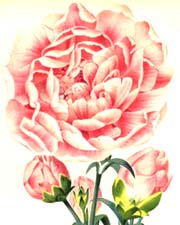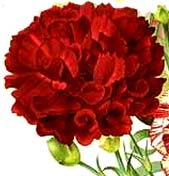 Dianthus caryophyllus Dianthus caryophyllus
Carnation - Clove
Pink
This magick herb is dedicated to Jove and of course ruled by
Jupiter. It is used in protection spells and to give strength and
health, as one would expect from a Jupiter herb. Gerard said a conserve
of the flowers comforts the heart, which Jupiter rules. Plant a border of clove
pinks around your entryway for Jovian protection and to enjoy
the spicy scent. Clove pink petals are also wonderful for strewing
in a magical context. The flowers' clove-like scent is helpful
in attaining trance and in astral work. White wine in which
an equal volume of petals have been steeped in the fridge overnight
makes a nice aid to divination. Top
Clove pinks came from the Near East and have been cultivated
for 2 millenia. Crusaders brought them back to Europe, where they were grown in medieval gardens and even in pots indoors. In the Middle
Ages, the petals were used as a substitute for cloves, which were more
expensive and had
to be imported, and the petals were steeped in rosewater that was used
as a medieval hair perfume. In the Renaissance, white wine infused
with the petals (until they are pale, then strain) was drunk as a nerve tonic that Culpeper said
strengthened the heart and by extension, the mind. They have been grown in New England since
before 1800. They were a Victorian favorite and were incorporated into
various languages of flowers used by young lovers. White blooms signified pure
love and good luck; red meant deep love; striped stood for unrequited
love, and pink represented either admiration or a woman's love. They
even became part of the Victorian clock of flowers, which was a secret code
used by young lovers to communicate meeting times through the
exchange of flowers:
|
Hours of the Victorian Flower Clock
|
|
1:00 Red Rose
2:00 Snapdragon
3:00 Violet
4:00 Field Daisy
5:00 Sweet pea
6:00 Marigold
|
7:00 Sweet William
8:00 Jonquil
9:00 Herb Robert
10:00 Clove Pink
11:00 Sweet Sultan
12:00 Carnation
|
This flower is also associated with the month of January and the sign of Sagittarius.
Top
This ancestor of florist's carnations has very fragrant flowers with a
spicy scent like cloves. The petals are edible. Take the flowers apart
and remove the bitter white heel at the bottom of each petal. Then they
can be sprinkled on salads, used as a garnish, made into a syrup for a
traditional treatment for the heart (see recipe), or mixed with sugar
to flavor it. The flowers can also be dried and used in pot pourri.
Clove pinks are also known as sops in wine, clove gilloflowers,
gillyflowers, jellyflowers, Jove's flowers, scaffold flowers, and hardy
carnations. Top
How to Grow Clove Pinks
 Freeze seeds for 5-7 days before sowing. Germinates at 70F/21C in 7
days.
Seedlings like cool temps once they are up (45-50F/7-10C) and then pot
up after 4 weeks. Harden off and then transplant to full sun 8 in/20cm
apart. They like alkaline soil, so don't plant them near pine trees;
close to a wall or to your driveway is good (it's salt tolerant). Or
sow outside in May or June for bloom the following year. Cut back after
flowering or deadhead. You can also plant in pots and then bring inside
to flower in winter. Plants get 20in/51cm tall. Blooms in white, rose,
pink, red, and striped. Hardy down to -20F/-28C and can be grown in hot
areas like Phoenix with afternoon shade. Best time to cut flowers is
mid afternoon. Cut when they are just opening for flowers that should
last 3 weeks. Or leave flowers on to collect
seeds, which ripen August-September. Clove pinks attract butterflies
but are tough enough to grow by the ocean or in polluted cities.
They're a great addition to cottage gardens. General growing info. Top Freeze seeds for 5-7 days before sowing. Germinates at 70F/21C in 7
days.
Seedlings like cool temps once they are up (45-50F/7-10C) and then pot
up after 4 weeks. Harden off and then transplant to full sun 8 in/20cm
apart. They like alkaline soil, so don't plant them near pine trees;
close to a wall or to your driveway is good (it's salt tolerant). Or
sow outside in May or June for bloom the following year. Cut back after
flowering or deadhead. You can also plant in pots and then bring inside
to flower in winter. Plants get 20in/51cm tall. Blooms in white, rose,
pink, red, and striped. Hardy down to -20F/-28C and can be grown in hot
areas like Phoenix with afternoon shade. Best time to cut flowers is
mid afternoon. Cut when they are just opening for flowers that should
last 3 weeks. Or leave flowers on to collect
seeds, which ripen August-September. Clove pinks attract butterflies
but are tough enough to grow by the ocean or in polluted cities.
They're a great addition to cottage gardens. General growing info. Top
|
Dianthus caryophyllus
Carnation
Clove Pink Mixture (pink,
red, white, striped)50 seeds $3.75

Uses in
Witchcraft & Magic:
Protection spells
Trance
Astral Work
Nice in cottage gardens
Clove Pink Syrup
Combine 1 cup water and 1 cup of sugar. Boil for 4 minutes, then add 1/2 cup of fresh
petals and let sit until petals are pale. Strain and bottle.
Store in fridge. You can use this same recipe for any edible
flower petal. Add another cup of sugar for a heavier syrup,
and vary the amount of petals to suit your taste.
© 2006-2024 Alchemy Works; No reproduction
without permission
|